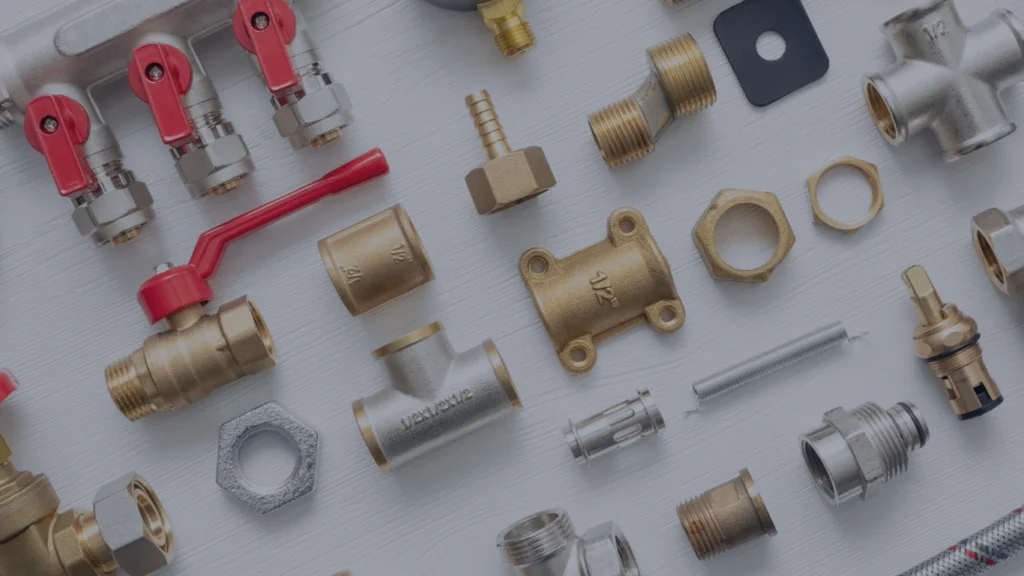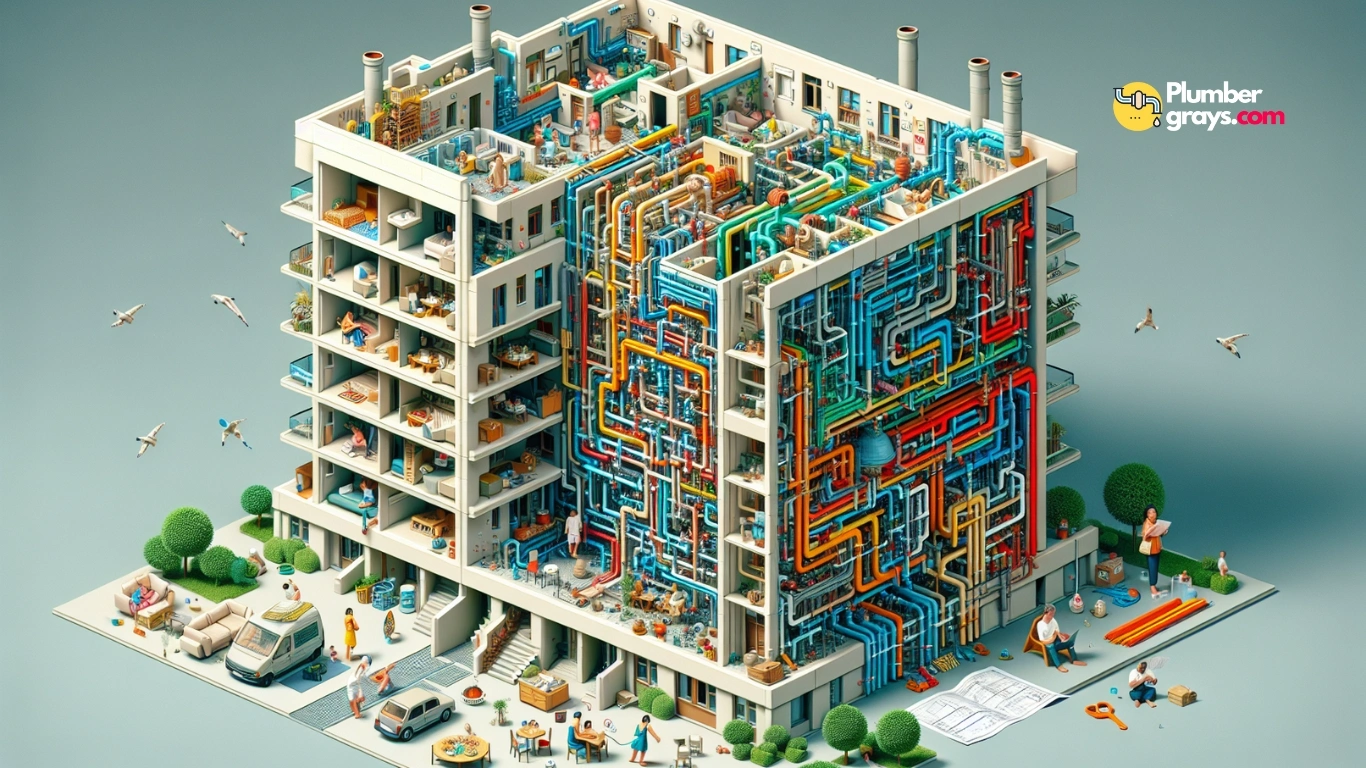Grasping the intricacies of how plumbing works in an apartment building is vital for addressing problems and ensuring the system operates efficiently. My in-depth analysis will shed light on the plumbing system in buildings, particularly focusing on the interplay between the inflow of fresh water and the outflow of wastewater, highlighting the complex challenges in multi-unit residences.
This article delves into the specifics of industrial plumbing, underscoring the importance of commercial backflow prevention, and offers insights that expand beyond the scope of a single-story house plumbing diagram. We’ll delve into the complex network of pipes that form the backbone of plumbing in interconnected apartment complexes.
Types of Plumbing Systems in Apartment Buildings
Apartment buildings depend on sophisticated apartment plumbing systems, which are broadly categorized into multiple story and multiple dwelling types. Let’s examine the mechanics behind these essential systems:
- Multiple Dwellings:
- Similar to single-family homes, but with additional branches for each unit.
- Each unit within an apartment is usually equipped with its own drain-waste-vent (DWV) system, a critical component for managing waste and safely venting plumbing gases.
- Multi-Story Dwellings:
- The plumbing in high-rise buildings is specifically engineered to address the distinctive challenges they face, such as maintaining water pressure and ensuring effective drainage.
- Utilize specialized systems for water pressure, such as:
- Gravity-based roof tanks that store and distribute water by gravity.
- Booster pumps that increase water pressure for higher floors.
- Hydro-pneumatic storage tanks that use compressed air to maintain consistent water pressure.
- Efficient waste removal in apartment buildings is facilitated by drainage systems comprising vertical stacks that run from the foundation to the rooftop.
- Key Components and Challenges:
- In apartment settings, control valves play an indispensable role in preventing cross-contamination and simplifying maintenance by isolating the water supply to individual units, effectively acting as water shut off valves for apartments.
- Complex plumbing systems within apartment buildings can lead to interconnected issues, as plumbing problems in one unit may affect others, especially when they share common lines.
- The freshwater system, crucial for distributing water, operates under pressure, while the wastewater system relies on gravity and proper venting to function effectively.
A thorough understanding of plumbing maintenance is vital for the effective upkeep and prompt resolution of issues, guaranteeing a reliable plumbing infrastructure for all residents.
RAED ALSO: How to Choose the Right Plumbing Tunneling Services
Water Supply and Pressure Management

During my investigation into apartment water systems, I’ve discovered that the science of managing water supply systems is intricate. Each apartment typically has individual freshwater pipes, with shared sections when necessary, ensuring that water is efficiently delivered to every part of the building.
- Pressure Management Techniques:
- Rooftop reservoir systems use gravity to distribute water from a rooftop tank.
- Booster pump systems are strategically utilized at different levels within a building to ensure that water pressure is consistent and reliable throughout.
- To maintain safety and adhere to regulations, water pressure reducing valves are essential for managing pressures that exceed 60 psi.
- Ensuring Equal Water Distribution:
- The task of providing an even water supply to all apartments becomes more challenging as the building’s height increases, which extends the distance water must travel.
- In high-rise buildings, booster pumps are crucial for enhancing water pressure, particularly when the municipal supply is insufficient.
- Optimal Pressure and Flow Rates:
- To prevent damage and ensure safety, regulations have set a cap on water pressure at 80 psi.
- To operate efficiently, plumbing fixtures require a specific psi, such as 8-20 psi, while a 3-story building typically needs around 50 psi.
- The recommended flow rates for various fixtures are established at 1.6 gallons per flush for toilets and a range of 1.5-2.5 gallons per minute for showerheads.
Essential maintenance tasks, including the inspection and replacement of leaky faucets and toilets, are vital for the smooth operation of plumbing systems. In Houston, multi-family commercial plumbing services are well-versed in managing these intricate systems.
Drainage and Waste Removal
From my hands-on experience with apartment plumbing, I’ve recognized the critical role of understanding the intricacies of drainage and waste removal systems.
- Clogged Drains: Clogs in sinks and tubs are often caused by accumulations of grease, hair, and soap residue. In my practice, I’ve found that using a plunger is typically effective, while avoiding harsh drain-cleaning chemicals to preserve the integrity of plumbing fixtures.
- Toilet Troubles: When faced with clogged toilets, I typically resort to using a plunger or a closet auger, the standard tools in toilets plumbing repair.
- System Structure: The apartment building plumbing diagram is comprehensive, featuring branch lines that connect each unit to the main vertical stacks, which are essential for efficiently directing wastewater in high-rise structures. These stacks, including waste, soil, and vent stacks, extend from the basement to the roof, while horizontal underground lines transport waste to the local sewer system, utilizing gravity.
- Maintenance Matters: Regular maintenance is crucial to avoid blockages in plumbing systems. I’ve discovered the Green Bull Waste Stack Treatment program by Greenpipe Biotech, which employs bacteria to decompose fats, oils, and grease, thereby diminishing the frequency of expensive plumbing services.
- Key Components: Key plumbing system components such as vents, traps or valves, and shutoff valves are integral to the smooth operation of a building’s drainage system, helping to sustain its health and efficiency.
Proactive oversight of these systems is essential to prevent clogs and avert backups, which helps keep our living environments sanitary and operational.
Common Plumbing Problems in Apartment Buildings

Throughout my experience in apartment maintenance, I’ve dealt with numerous common plumbing issues that can quickly become bothersome and expensive if not resolved swiftly. Here’s an overview of some typical problems and strategies for managing them:
- Leak Troubles:
- FaucetsA leaking faucet is more than a mere inconvenience; it can escalate your water bill and inflict damage [14]. To tackle this, I turn off the water supply, inspect for any loose components, and often discover that swapping out deteriorated rubber washers is an effective solution [14].
- ToiletsA running toilet can be a significant source of water waste. Addressing this issue by replacing the flapper valve is often the swift solution needed to halt the running toilet and conserve water.
- Garbage DisposalsWhen the disposal is not working, it’s wise to avoid fibrous foods and press the reset button. Should leaks appear below the sink, it’s imperative to seek immediate assistance from a plumber to prevent water damage and ensure the disposal not working is promptly fixed.
- Flooding and Overflows:
- To prevent flooding, remain alert for signs of potential overflows and conduct regular inspections of your appliances. This vigilance helps avert water-related disasters caused by poor drainage, compromised pipes, or unintended overflows.
- Water Heater Woes:
- A leaking water heater tank poses a significant risk to the integrity of a building. Securing the services of a knowledgeable plumber is essential to address the issue and explore the most suitable replacement options for the compromised water heater tank.
- Freezing Fears:
- Implementing good insulation of plumbing pipes is a strategic measure for landlords aiming to minimize the chances of pipes freezing. It’s equally important for tenants to be informed on effective strategies to keep pipes from freezing during emergency situations.
- Preventive Practices:
- Regular plumbing inspections are a critical responsibility for building managers, ensuring the health of pipes and water heaters is maintained. Utilizing drain screens and monitoring for signs of dirty water are proactive steps to ward off plumbing problems. It’s crucial to recognize that an issue in one unit can have repercussions throughout, particularly if the units are connected by a shared line.
- Maintenance Records:
- Maintaining comprehensive records of all engagements with plumbing and drain cleaning services, including the work performed and expenses incurred, is advantageous for tracking maintenance history and managing future plumbing needs.
By recognizing these common problems and committing to regular maintenance, we can reduce the likelihood of plumbing issues and maintain a smoothly operating system for the benefit of all residents.
- Maintaining comprehensive records of all engagements with plumbing and drain cleaning services, including the work performed and expenses incurred, is advantageous for tracking maintenance history and managing future plumbing needs.
Conclusion
Our journey through the complexities of apartment building plumbing has highlighted the critical role of regular maintenance in managing water supply and ensuring efficient wastewater disposal. This level of attention is crucial for the comfort and safety of residents, preventing common plumbing issues and fostering a peaceful coexistence within the apartment community.
Reflecting on our discussions, it’s clear that the challenges of apartment plumbing require proactive measures and expertly crafted solutions. Engaging professional plumbing services is a decisive step in preserving a dependable and efficient water flow. To protect your property from plumbing emergencies, timely intervention from seasoned professionals is paramount—consider our Houston-based plumbing services for optimal system performance.
FAQs
Q: Can you explain how plumbing is set up in an apartment complex?
A: Within an apartment complex, the plumbing work mirrors that of a single-family residence but on a larger scale, with an extensive network of pipes serving each unit. The system taps into the municipal water supply and employs a complex network of pipes, faucets, and valves to deliver water where it’s needed in the building.
Q: Are the plumbing pipes interconnected throughout an entire apartment building?
A: Indeed, the plumbing in an apartment building features an interconnected web of vertical stacks and horizontal pipes, complemented by branch lines that forge connections between units. While the entire system is unified, typically, each apartment interacts with specific pipes or sections of the plumbing network, rather than the whole.
Q: How is the water distribution system organized within an individual apartment?
A: The apartment plumbing system ensures water delivery through a main supply pipe that taps into the municipal source. This conduit branches out to various apartment zones, like the kitchen and bathrooms, via a network of pipes, faucets, and valves, designed to supply both hot and cold water to key areas of the home.
Q: What is the best way to detect plumbing hidden behind walls?
A: To locate plumbing behind walls, employing a stud finder can be effective, as it’s engineered to detect hidden pipes. This device is handy for DIY enthusiasts aiming to pinpoint pipe positions. Nonetheless, for more accurate detection, professional plumbers might opt for advanced pipe detectors.


Comments are closed